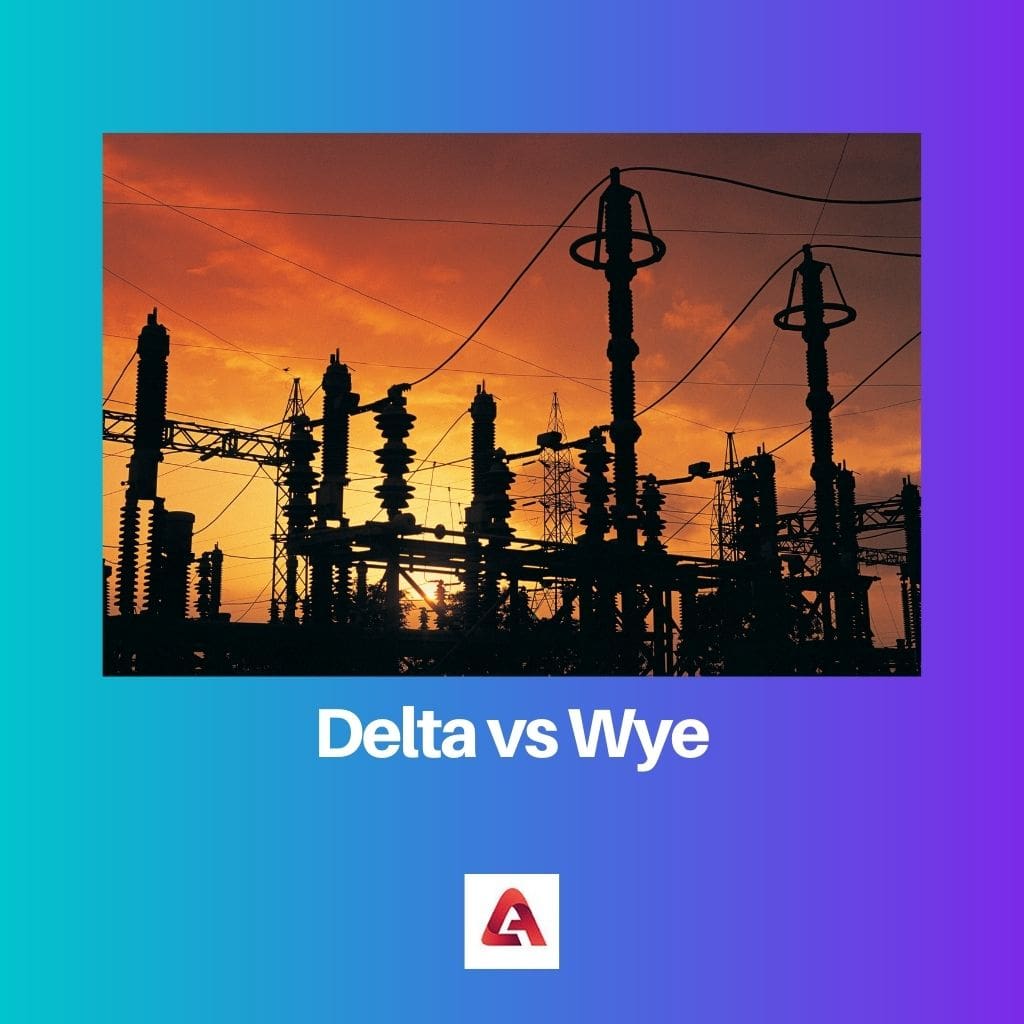The terms delta and wye can be found in the electrical power distribution field; specifically, these terms belong to the three-phase system. Delta and wye are different types of configurations present within the three-phase system.
Key Takeaways
- Delta and Wye are two configurations for connecting electrical components, specifically three-phase systems in power distribution and electrical engineering.
- Delta configuration forms a closed loop, with each component connected end-to-end, creating a triangular shape. It is used for higher-power applications because it handles higher voltages and currents.
- Wye configuration connects one end of each component to a common central point, forming a Y shape, and is used in applications requiring a neutral wire for grounding or balancing voltage.
- Both configurations have unique advantages and applications, with Delta providing higher power capabilities and Wye offering grounding and voltage balancing options.
Delta vs Wye
The difference between delta and wye connections is that the former is a system consisting of four wires, three of which are in triangular connections and has no neutral wire. At the same time, the latter is joined in a star connection with a neutral cable.

Delta connection systems have four wires in total. It has three phases connected in the form of a triangle. There is no neutral cable, but there is one ground wire.
The wye connection system has five wires, of which three hot wires are connected to a neutral wire. The Wye system utilizes a star connection.
Comparison Table
| Parameters of comparison | Delta | Wye |
|---|---|---|
| Number of wires | The total number of wires in a delta connection system is four, with three wires connected to one ground cable. | The total number of wires in a wye connection system is five, with three hot wires connected to a single neutral wire. |
| Neutral cable | Delta connection system does not include the use of a neutral line. | The wye connection system does include the use of a neutral cable. |
| Shape of connection | A delta system is connected in a triangular shape configuration. | A wye system is connected in a “Y” shape or configured in a star shape. |
| Phase voltage | In a delta system configuration, the phase voltage equals the line voltage. | In a wye system configuration, the phase voltage is equivalent to the line voltage divided by the root of 3. |
| Phase load | In the delta system, the phase load or single-phase load is seen to pass through only one wire/phase. | In the wye system, the phase load or single-phase load is seen to pass through all wires. |
| Cost of installation | The delta system can be costlier to install than the wye system. | The wye system is cheaper in terms of maintenance and installation. |
What is Delta?
The delta configuration is part of the three-phase system (in the field of electrical power distribution). Here, the configuration mainly focuses on how the wires are arranged and connected to provide lower phase voltage.
In the delta configuration, the total number of wires involved is four, with three wires connected to one ground wire. In delta systems, there is also no neutral wire required.
In a delta system configuration, the phase voltage is equal to the line voltage and is depicted as shown below –
Phase voltage (Vp) = Line Voltage (VL)
Also, one primary factor in delta systems is that the phase load or single-phase load is seen to pass through only one wire/phase.
Regarding maintenance and installation, delta system connections are costlier than wye systems.
What is Wye?
The wye system is one of the two different configurations of the three-phase system (in the field of electrical power distribution). The wye configuration has better helped reduce the phase voltage required in a system.
In a wye system, the wires are connected as a “Y”; hence the system’s name is “wye”. Also, the cables can be combined as a “star”.
In a wye system configuration, the phase voltage is equivalent to the line voltage divided by the root of 3 (1.732) and is depicted as shown below –
Phase voltage (Vp) = Line Voltage (VL) / 1.732
In the wye system configuration, the phase load or single-phase load is seen to pass through all wires. The wye system is also cheaper for installation and maintenance than the delta connection in the three-phase system.

Main Differences Between Delta and Wye
- A delta connection system has four wires, with three wires connected to one ground cable. In a wye system, there are five wires.
- No neutral cable is involved in the connection in the delta system configuration, while a neutral line is required in the wye system.
- Delta system is less expensive in terms of maintenance, installation, and purchase of wires than the wye system configuration.
- In a delta system configuration, the phase voltage is equal to the line voltage, while in a wye system, the phase load or single-phase loads is seen to pass through all wires.
- A delta system is connected in a triangular shape configuration, while a wye system is connected in a “Y” shape or configured in a star shape.
- https://ieeexplore.ieee.org/abstract/document/5677478/
- https://digital-library.theiet.org/content/journals/10.1049/ip-c.1992.0035

This article provides a comprehensive analysis of the delta and wye configurations in a three-phase system. It helps to understand the key differences between the two and their applications. Excellent work!
I completely agree. The article is very informative and well-structured.
The comparisons made are very clear and easy to understand. Great job!
The article is quite informative and provides a good overview of delta and wye connections, making it easier to understand the complexities of the electrical power distribution system.
Absolutely, the detailed explanation makes it accessible even to non-experts.
The article brilliantly dissects the differences between delta and wye configurations, providing a profound understanding of the topic.
Indeed, the depth of analysis is commendable and enriching.
The article serves as an excellent reference for professionals seeking to enhance their knowledge of delta and wye configurations, contributing to the intellectual discourse in the field.
Agreed, the article offers substantial insights for industry practitioners and academics alike.
The article presents a well-structured comparison between delta and wye configurations, catering to those with a high level of understanding in the field of electrical engineering.
Indeed, the article is well-suited for professionals and enthusiasts in the field.
The content is comprehensive and intellectually stimulating. Well-written and insightful.
The intellectual depth of the article makes it a valuable resource for industry professionals. It covers the topic comprehensively and analytically.
Absolutely, the detailed analysis makes it beneficial for industry practitioners.
It’s a comprehensive and well-researched piece that adds significant value to the field.
The complexity of the article may be overwhelming for beginners, but it certainly provides valuable insights for those with a deeper knowledge of the subject.
I agree. The article delves into the intricacies of the topic, making it more suitable for experts.
While the article is explanatory, it is too technical and might be difficult for beginners to absorb all the information.
I agree. It would be helpful if the article included more simplified examples for better understanding.
The article provides an intellectual comparison of the two configurations and their advantages and disadvantages. It is a great resource for professionals in the field.
I appreciate the depth of information provided in the article. It’s beneficial for those seeking in-depth knowledge.
Absolutely! It’s a valuable resource for those in the electrical engineering industry.